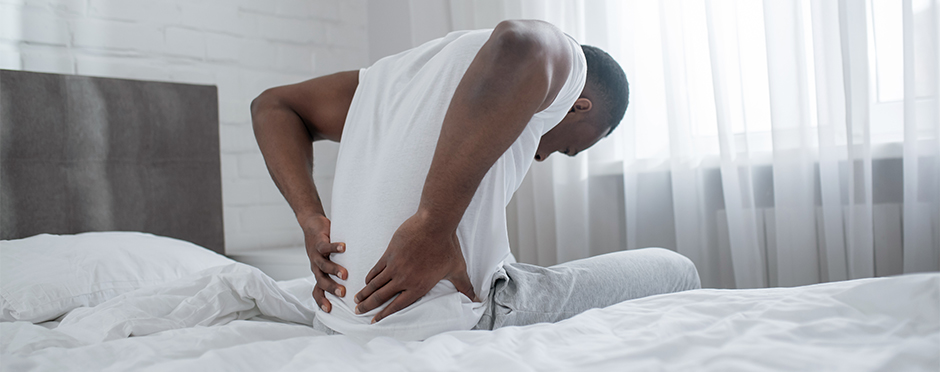
Back Pain Quiz: Put Your Knowledge to the Test!
Leave a CommentBack pain is one of the most common conditions that physical therapists treat. It can occur from a variety of reasons, and impact each person differently, but one thing is for sure – no one wants it. If left untreated, back pain can get in the way of daily activities such as work, exercising, and spending time with family and friends. How much do you know about back pain? Put your knowledge to the test with the following quiz!
1. Back injuries are rare and only occur in people who perform heavy labor jobs or participate in sports.
Nearly 40% of adults have experienced back pain at some point, and it is expected that 80% of the population will experience low back pain at some point. Physical stress is not the only predictor of low back pain. Smoking, excess body weight, lack of exercise, and psychological stress all increase the risk of low back pain.
2. If you have back pain, you should get an X-ray, MRI, or CT scan to find the cause.
Findings in medical imaging rarely explain the causes of your pain. “Degenerative” results are very common, even in those people who don’t have any pain!
3. Discs and joints can fall out of place, and you will require a medical specialist to put them back in place.
There is zero evidence in the research that supports this claim. Your spine is a robust structure that will not fall out of place.
4. The most important exercises for back pain are core stability exercises.
Although core stability training is beneficial, the research has found that it is no more beneficial compared to general strengthening or cardiovascular exercise.
5. What combination is the most effective treatment for low back pain?
Exercise and education. Research strongly supports a combination of education for patients about their pain along with a variety of cardiovascular and strengthening exercises to effectively treat low back pain.
6. Acute low back pain is pain that occurred a few days or a few weeks ago. Which of the treatment options below are helpful in decreasing pain in the acute phase?
All these treatment options have been found to provide relief from pain and have been found to be more helpful when performed together.
7. Which type of treatment has been found to be ineffective at treating low back pain?
Research strongly suggests that opioid medication, back braces, and bed rest provide no improvements in those suffering from low back pain. These are very passive treatments and can even make symptoms and your physical state worse.
If you’d like to learn more about your back pain and how physical therapy can help, call your local Athletico clinic today and request a Free Assessment. Free assessments are available in-clinic and virtually through our telehealth platform.
*Per federal guidelines, beneficiaries of plans such as Medicare, Medicaid, Tricare, VHA and other federally funded plans are not eligible for free assessments.
The Athletico blog is an educational resource written by Athletico employees. Athletico bloggers are licensed professionals who abide by the code of ethics outlined by their respective professional associations. The content published in blog posts represents the opinion of the individual author based on their expertise and experience. The content provided in this blog is for informational purposes only, does not constitute medical advice and should not be relied on for making personal health decisions.
References:
1. Urits, I., Burshtein, A., Sharma, M. et al. Low Back Pain, a Comprehensive Review: Pathophysiology, Diagnosis, and Treatment. Curr Pain Headache Rep 23, 23 (2019). https://doi.org/10.1007/s11916-019-0757-1
2. Bialosky, J., George, S., Bishop, M. How Spinal Manipulative Therapy Works: Why Ask Why?. J Orthop Sports Phys Ther. 2008;38(6):293–295. doi:10.2519/jospt.2008.0118
3. Owen PJ, Miller CT, Mundell NL, et al
Which specific modes of exercise training are most effective for treating low back pain? Network meta-analysis
British Journal of Sports Medicine 2020;54:1279-1287.
4. Oliveira, C.B., Maher, C.G., Pinto, R.Z. et al. Clinical practice guidelines for the management of non-specific low back pain in primary care: an updated overview. Eur Spine J 27, 2791–2803 (2018). https://doi.org/10.1007/s00586-018-5673-2
5. Hu HT, Gao H, Ma RJ, Zhao XF, Tian HF, Li L. Is dry needling effective for low back pain?: A systematic review and PRISMA-compliant meta-analysis. Medicine (Baltimore). 2018 Jun;97(26):e11225. doi: 10.1097/MD.0000000000011225. PMID: 29952980; PMCID: PMC6242300.
6. Shipton, E.A. Physical Therapy Approaches in the Treatment of Low Back Pain. Pain Ther 7, 127–137 (2018). https://doi.org/10.1007/s40122-018-0105-x
7. Schott C, Zirke S, Schmelzle JM, Kaiser C, Fernández LAI. Effectiveness of lumbar orthoses in low back pain: Review of the literature and our results. Orthop Rev (Pavia). 2018 Dec 6;10(4):7791. doi: 10.4081/or.2018.7791. PMID: 30662686; PMCID: PMC6315306.
